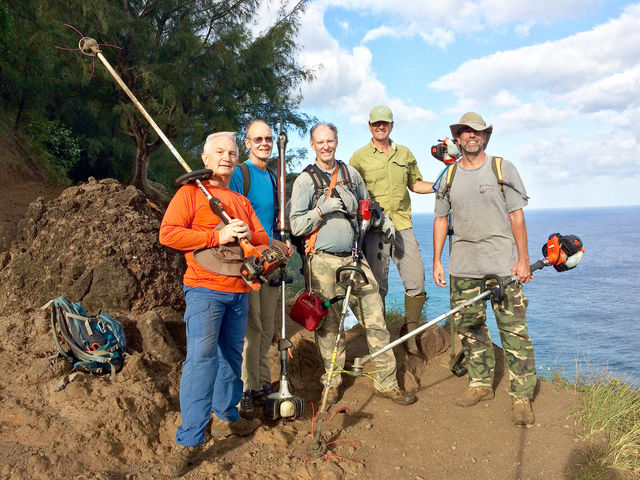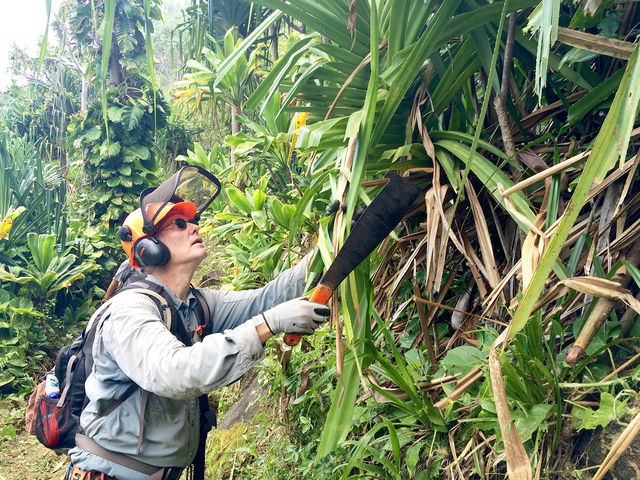Early in the morning, when the air is cool and the sun is gentle, all is quiet on the Kalalau Trail, save for the songbirds flitting tree to tree and the ocean’s distant rumble. On Saturday, Mark Hubbard cut through
Early in the morning, when the air is cool and the sun is gentle, all is quiet on the Kalalau Trail, save for the songbirds flitting tree to tree and the ocean’s distant rumble.
On Saturday, Mark Hubbard cut through that serenity like a morning alarm with the ratchety moan of his weed-whacker.
For the next four hours, the machine droned on, except when Hubbard would pause to make room for hikers passing by, take a swig of water or point out something to one of the other four men armed with mechanical brush cutters.
“Hey, Dave,” said Hubbard, “look at this fern! The more we cut it, the more it grows!”
David Cougill whipped off his noise-canceling headphones. He redirected his gaze to the eight-inch fern leaves sprouting from a rock wall bordering the mauka side of the trail and let out an all too well knowing chuckle. Then he rendered his verdict: “Job security.”
Erosion, general wear and tear from hikers and the ever-encroaching jungle are among the top threats to trail safety that a small band of volunteers battle in their twice monthly missions to maintain the primary two-mile stretch of the Kalalau Trail that begins at Kee Beach on Kauai’s North Shore.
Built in the 1860s, the snaking, slippery cliffside trail that is 11 miles long along the Na Pali Coast and in some places less than a foot wide is widely considered one of the most dangerous hikes in the nation. The expanse of trail that the group maintains — by far the most popular section — is tread on by about 500 hikers a day.
The mainstays of the trail maintenance group are Hubbard and Cougill as well as Frank Whitman, Tommy Noyes and Bill Newton. The men, who span the ages of 54 to 68, share in an almost devout respect for the trail. They also have an affinity for volunteerism.
“The wider it is, the safer it is,” said Cougill, who is 54 and lives in Princeville. “Everything we do is about safety.”
On Saturday, the group focused on brush cutting. They slashed overgrown naupaka and lauhala plants, leaving a carpet of green clippings over what had been a trail of bare rock and dirt. That’s where this reporter came in, hauling the clippings over the side of the cliff with a rake.
It’s rare, but not unheard of, that the core group of five has an extra set of helping hands. Sometimes a newbie will chip in for a day of tree root clearing, but they rarely return. The group insists their lackluster volunteer retention rate is because the work is hard — not because the company is poor.
“Yes, we do this and we’re not prisoners or nothin’,” Cougill tells passersby on the trail with a grin.
Today, the trail is in good shape. But it wasn’t long ago that an archaeological survey found it was more than 90 percent eroded due to foot and animal traffic as well as 150 years of heavy rain. So in 2009, the trail underwent major rehabilitation work on its primary two-mile stretch after the nonprofit Kauai Planning and Action Alliance secured grant-in-aid funding from the state for improvements. When that 14-month project wrapped up, the volunteer group formed with the goal of keeping up the improvements.
“There were places where whole sides of the trail had fallen away,” said Whitman, a retired clinical social worker from Lihue. “The state hired workers to come in and make a clear, safe, passable trail. And we try to make sure all their work remains in good shape.”
Apart from the gorgeous views, the men say a major perk of maintaining the trail is the thanks they receive from virtually every hiker they pass by. The appreciation of those who use and love the trail is the motivation that brings them back for more weed trimming and rock realignment every other week.
“It’s my way of giving back to this beautiful place,” Cougill said. “It’s my way of reloading my aloha bank.”




